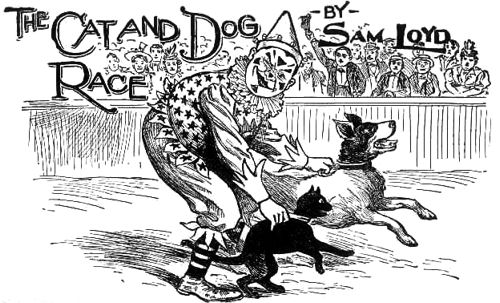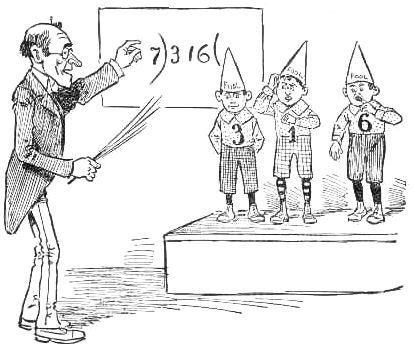



MANY years ago, when Barnum's Circus was of a truth '' the greatest show on earth," the famous showman got me to prepare for him a series of prize puzzles for advertising proposes, which became widely known as the Questions of the Sphinx, on account of the large prizes offered to any one who could master them.
Barnum was particularly pleased with the problem of the cat and dog race, and published it far and wide that on a certain first day of April he would give the answer and award the prizes, or, as he aptly put it, "let the cat out of the bag. For the benefit of those most concerned."
The wording of the puzzle was as follows:
A trained cat and dog run a race. 100 feet straightaway and return. The dog leaps three feet at each bound and the cat but two, but then she makes three leaps to his two. Now, under those circumstances, what are the probabilities or possibilities in favor of the one that gets back first?
It looks childlike and bland, as Bret Harte would say, but the fact of the answer to he made public on the first of April, and the sly reference to "letting the cat out of the bag." was enough to intimate to the public that the great showman had some funny answer up his sleeve Can you solve the puzzle?
In Barnum's great puzzle it was said that “A trained cat and dog run a race 100 feet straightaway and return. The dog leaps three feet at each bound and the cat two feet. Then she makes three leaps to the dog's two,” and the puzzle was to tell what were the possibilities of the race.
Now, the cat wins, of course. It has to make precisely 100 leaps to complete the distance and return. The dog, on the contrary, is compelled to go 102 feet and back. Its thirty-third leap takes it to the 99-foot mark and so another leap, carrying it two feet beyond the mark becomes necessary. In all, the dog must make 68 leaps to go the distance. But it jumps only two-thirds as quickly as the cat, so that while the cat is making 100 leaps the dog cannot make quite 67.
But the puzzle turns upon the possibilities of the race, just let us suppose that the cat is a Sir Thomas cat and the dog Blance is one referred to as she. Then the possibilities which Barnum had up his sleeve would read; "A cat and a dog run a 100-foot straight away race and return. The dog makes three leaps to the cat's two." So the dog really goes 9 feet to the cat's 4. As the dog finishes the race in 68 leaps, the cat will have gove but 90 feet and 8 inches.
2. A Study in Division.

Here is a cute little arithmetical study, told in the style of Mother Goose, which shows how in the days of auld lang syne the pedagogues were wont to punish the dunces in true Mikado fashion "by making the punishment fit the crime."
The sketch shows three little dunces who failed ignominiously to do that simple sum in division on the blackboard, so, as the story says:
Those stupid boys, who were so dumb.
They could not do a simple sum.
Were marked with numbers three, one, six.
And told those numbers they could mix,
And find by many changes tried
A sum which seven would divide!
You will say the answer is so plain
That all who fail, dunce caps should gain!
That study in division was solved by a little boy No. 6.
Standing on his head so that the number 931 was divisible by 7.
[Page 19]